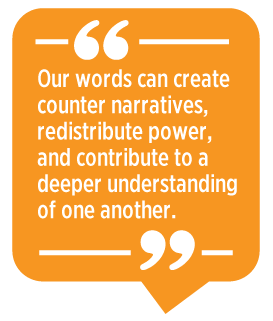If We Must Label Language Learners: EL vs. MLL
by Raichle Farrelly

What’s in a label? In this article, I reflect on the labels that we use
in our field to refer to those learning English as an additional
language, and how those labels matter. A few of my intersecting
identities—linguist, teacher educator, TESOL program director, language
learner, activist—demand that I reflect on the role language plays in
assigning social meaning and contributing to identity formation.
One of my favorite classes in my Introduction to Linguistics
course entails an exploration of “everyday language you didn’t know was
racist.” Students often experience some dissonance when trying to think
differently about language they have used for a lifetime (“I can’t say
‘gypped’ anymore?!”). I share with them that when we reach the other
side of deep reflection and enact language practices that uplift—rather
than oppress—it can be liberating. It’s important to dive in and
consider how our language impacts others. In fact, our words can create
counter narratives, redistribute power, and contribute to a deeper
understanding of one another.
The terms we use to refer to others (and ourselves) will
constantly evolve—until they don’t. In a 1994
op-ed piece for The New York Times,
Pinker wrote “The euphemism treadmill shows that concepts, not
words, are in charge: give a concept a new name, and the name becomes
colored by the concept; the concept does not become freshened by the
name.” However, he goes on to assert that when the labels used for
certain groups remain, we have reached a place of mutual respect. Can
you think of positive or neutral labels for groups that have stood the
test of time?
Despite the challenges faced in coming to some semblance of
agreement about terminology, words and labels matter, and one way to
show up for underrepresented or marginalized populations is to lean in,
listen, and (un)learn. Many of us, for example, have learned the meaning
behind each part of the acronyms BIPOC and LGBTQIA2S+, as well
as the fact that the latter expanded acronym is neither complete nor
perfect in its capacity to reflect gender complexity. Learning and
reflecting on labels and applying them mindfully and with respect are
ways we can elevate each other—to honor all that each brings to the
table, and to make sure there is a seat at the table for everyone in the
first place.
 TESOL has been called to move beyond being an association committed to contributing to the research, practice, and service
endeavors related to English (only) language teaching and learning. In
recognition of the full linguistic repertoire of language learners and
in celebration of linguistic diversity, TESOL is increasing its focus on
multilingual education, benefits of translanguaging, and ways to
leverage home languages in and out of the classroom. Additionally, TESOL
is aware of the need to reconsider the labels assigned to those for
whom English is an additional language. In the United States, Canada,
and other English-dominant countries, the labels used to denote students
for whom English is not the native or home language contribute to
decisions about policy, assessment, and placement in schools and
programs. They also influence perceptions held about these learners by
various individuals, including peers at school, teachers, community
members, and politicians. Students themselves have demonstrated concerns
about and resistance to how they are labeled in their schools (Oropeza,
et al., 2010; Shapiro, 2014).
TESOL has been called to move beyond being an association committed to contributing to the research, practice, and service
endeavors related to English (only) language teaching and learning. In
recognition of the full linguistic repertoire of language learners and
in celebration of linguistic diversity, TESOL is increasing its focus on
multilingual education, benefits of translanguaging, and ways to
leverage home languages in and out of the classroom. Additionally, TESOL
is aware of the need to reconsider the labels assigned to those for
whom English is an additional language. In the United States, Canada,
and other English-dominant countries, the labels used to denote students
for whom English is not the native or home language contribute to
decisions about policy, assessment, and placement in schools and
programs. They also influence perceptions held about these learners by
various individuals, including peers at school, teachers, community
members, and politicians. Students themselves have demonstrated concerns
about and resistance to how they are labeled in their schools (Oropeza,
et al., 2010; Shapiro, 2014).
Critical reflections on the nature and application of deficit
discourse about individuals using English as an additional language have
led to an avoidance of labels such as limited English
proficient (LEP). Seemingly more asset-oriented labels like English language learner (ELL) have become more
commonplace. However, in their article “Labels as
Limitations,” Kleyn and Stern (2018) note that
while the new term English Language Learner (like its cousin,
English Learner or EL) removes the word "limited," it still focuses on
what students are lacking: English. Students are positioned not as
learners of math, science, or social studies, nor as artists, athletes,
or poets.
To reflect the dynamic nature of language learning as well as
students’ linguistic capital, García and Kleifgen (2010) proposed the
term emergent bilingual; however, the adjective emergent generally means “coming into being,” so
for those who are advanced bilinguals, the label emergent
bilingual seems to discount the extent to which they have
developed proficiency in the language; yet advanced
bilingual doesn’t take into account newcomers who are
learning a new language for the first time. Some of our colleagues
embrace the label culturally and linguistically
diverse (CLD) students. In some states in the United States,
the education endorsement for teachers working with this population is
referred to as a CLD endorsement. The issue some have with that label is
that it doesn’t distinguish those learning English as an additional
language from students of various cultural backgrounds who speak
varieties of English that are not legitimized in academic settings, such
as African American Vernacular English (AAVE) or Black English (BE) in
the United States.

Gunderson (2020) notes that the ELL/EL category is implicitly
deficit based because it homogenizes an otherwise multidimensional group
of individuals—typically determining inclusion in the category on the
sole feature of English ability. As TESOL practitioners, we are among
the first to recognize that learners of English as an additional
language vary tremendously in terms of home language(s), cultural
background, age, gender, socioeconomic status, educational experience
and expectations, familial capital, academic goals, personal interests,
personality, and so much more! Accordingly, we should also recognize that any
label, no matter how equitable we perceive it to be, will likely remain
problematic in its inability to truly reflect the kaleidoscope of
characteristics that makes up each individual.
So where are we now—as a field, as a community, as an
organization? TESOL has moved toward the use of
“MLL”—multilingual language learner—in place of ELL
or EL in an effort to recognize the assets, funds of knowledge, and
linguistic capital of all individuals using English as an additional
language. Will this label be embraced on a global scale? Will it have an
impact on the ways in which learners are perceived? Will it stand the
test of time? Will it be viewed as equitable and respectful by those to
whom it refers? I suppose the optimist in me would say—maybe? This
reflection is simply an invitation to be mindful of how we refer to MLLs
and to engage in conversations with students and colleagues about
labeling. What does the hive mind in your context think, and how will
that impact language, policy, and action in your educational
spaces?
In closing, I propose a few playful interpretations of
well-known acronyms: ELLs = experts in language learning and EALs =
experts in acquiring languages, and a few new ideas: EMLs = experts in
multiple languages and MOLs = masters of languages. Perhaps a short
lesson on acronyms with MLLs in your context will bring us to the next
best label!
References
García, O., & Kleifgen, J. A. (2010). Educating emergent bilinguals: Policies, programs, and
practices for English learners. Teachers College Press.
Gunderson, L. (2020) The consequences of English learner as a
category in teaching, learning, and research. Journal of
Adolescent & Adult Literacy, 64(4), 431–439. https://ila.onlinelibrary.wiley.com/doi/10.1002/jaal.1116
Kleyn, T., & Stern, N. (2018). Labels as limitations. MinneTESOL Journal 34(1). https://minnetesol.org/archives/3886
Oropeza, M. V., Varghese, M. M., & Kanno, Y. (2010).
Linguistic minority students in higher education: Using, resisting, and
negotiating multiple labels. Equity & Excellence in
Education, 43(2), 216–231.
Pinker, S. (1994, April 5). The game of the name [Opinion]. New York Times. https://www.nytimes.com/1994/04/05/opinion/the-game-of-the-name.html
Shapiro, S. (2014). “Words that you said got bigger”: English
language learners’ lived experiences of deficit discourse. Research in the Teaching of English, 48(4), 386–406.
Raichle Farrelly, PhD, is an associate teaching professor and director of the TESOL Program for the Department of Linguistics at the University of Colorado Boulder. She offers courses on a range of topics, including language teaching methods, teaching L2 oral skills, pedagogical grammar, world language policy, the TESOL Practicum, and introduction to linguistics. Her professional interests include L2 teacher education, reflective teaching, curriculum design, community engaged learning, and teaching refugee-background adults.